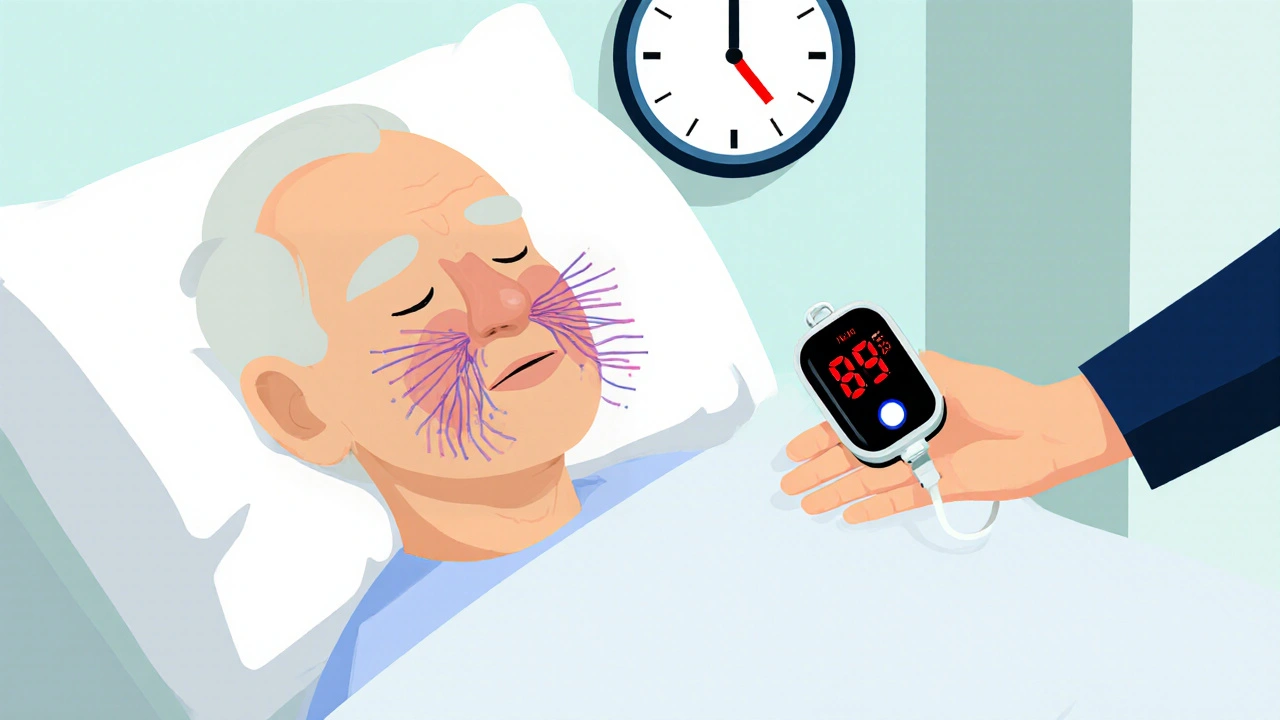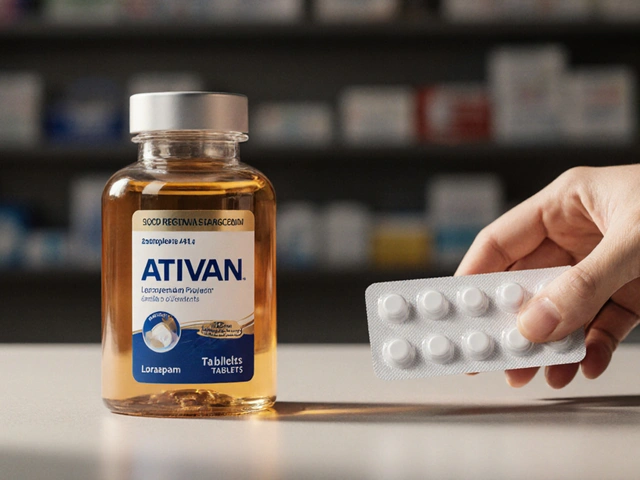Opioid Risk Calculator
Assess Your Risk of Respiratory Depression
This tool estimates your risk of opioid-induced respiratory depression based on key medical factors. Your results will help you understand your risk level and what steps to take.
Every year, 20,000 people in the U.S. need naloxone to save their lives after their breathing slows to a dangerous stop-often because of pain medication they were prescribed. This isn’t rare. It’s predictable. And it’s preventable.
What Exactly Is Opioid-Induced Respiratory Depression?
Opioid-induced respiratory depression (OIRD) isn’t just "feeling sleepy" after taking pain pills. It’s when your brain stops telling your lungs to breathe. The brainstem, which controls automatic functions like breathing, gets suppressed by opioids. Your breaths become shallow, slow, and irregular. You might take fewer than 8 breaths per minute. Your body stops reacting to low oxygen or rising carbon dioxide levels. That’s the danger. Your body no longer knows it’s in trouble.
This isn’t limited to heroin or street drugs. It happens in hospitals, nursing homes, and living rooms. Patients on prescription oxycodone, hydrocodone, morphine, fentanyl, or even codeine can develop it. And it’s not just opioids. Mixing them with benzodiazepines like Xanax or Valium, alcohol, sleep aids, or muscle relaxants can make the risk 14.7 times higher.
The 6 Critical Signs of Respiratory Depression
Waiting for someone to turn blue or stop breathing entirely is too late. By then, brain damage may already be happening. Here are the real warning signs-backed by clinical data:
- Slow breathing (under 8 breaths per minute)-This is the most consistent sign. Normal is 12-20. Below 10 is a red flag. Below 8 is a medical emergency.
- Oxygen saturation below 85%-Pulse oximeters show this. But here’s the trap: supplemental oxygen can hide this. Someone might have 95% oxygen on a mask while their CO2 levels climb to deadly levels. That’s why capnography (measuring exhaled CO2) is more reliable in high-risk cases.
- Extreme drowsiness or inability to wake up-Not just tired. Not just groggy. You can’t rouse them with loud noise or shoulder shaking. This is CNS depression in action.
- Confusion, disorientation, or slurred speech-They don’t know where they are, what time it is, or who you are. This isn’t normal drowsiness. It’s brain function shutting down.
- Slow or irregular heartbeat-Early on, you might see fast heart rate (tachycardia). Later, as oxygen drops further, the heart slows (bradycardia). Either way, it’s a sign the body is failing.
- Nausea, vomiting, or dizziness-These aren’t just side effects. They’re early neurological signals. In fact, 65% of confirmed OIRD cases include nausea or vomiting.
Don’t wait for all six. One or two, especially slow breathing and unresponsiveness, should trigger immediate action.
Who’s at Highest Risk?
Not everyone who takes opioids gets respiratory depression. But some people are far more vulnerable:
- Age 60+-Risk triples. Older bodies process drugs slower. Lungs are weaker. Brain sensitivity increases.
- Opioid-naïve patients-People who’ve never taken opioids before are 4.5 times more likely to have a dangerous reaction. That’s why fixed-dose schedules for first-time users are dangerous.
- Women-Studies show women have a 1.7x higher risk than men, possibly due to body composition and metabolism differences.
- Multiple health conditions-Each additional illness (like COPD, sleep apnea, heart failure) increases risk by nearly 3x.
- Combining medications-Mixing opioids with benzodiazepines, alcohol, or sleep aids is the #1 preventable cause of fatal respiratory depression. The risk jumps 6.3x with benzodiazepines alone.
If someone fits even two of these categories, they’re in the high-risk group. That means they need continuous monitoring-not checks every 4 hours.
Why Checking Vital Signs Every 4 Hours Is Dangerous
Many hospitals still use the old model: check breathing, heart rate, and oxygen every 4 hours. That means a patient is unmonitored 96% of the time. If respiratory depression starts at 10:15 PM, and the next check is at 2:00 AM, that’s nearly 4 hours of silent, deadly decline.
Real-time monitoring saves lives. Capnography-which measures carbon dioxide in exhaled breath-is the gold standard when patients are on oxygen. It detects rising CO2 before oxygen levels drop. Pulse oximetry alone misses up to 40% of early cases. That’s why leading hospitals now use continuous monitoring for high-risk patients.
And it works. Hospitals that implemented continuous monitoring for patients with two or more risk factors saw a 47% drop in OIRD events.
What Happens If You Don’t Act?
Untreated respiratory depression doesn’t just lead to death. It leads to brain injury from lack of oxygen. Even if someone survives, they may have lasting cognitive damage-memory loss, trouble concentrating, personality changes.
And it’s not just the patient. Hospitals are now fined for these events. Since 2020, the Centers for Medicare & Medicaid Services (CMS) classifies severe OIRD as a "never event." That means they won’t pay for the extra care needed to treat it. Hospitals can lose up to 3% of their entire reimbursement rate.
That’s why the market for monitoring devices has grown from $287 million in 2020 to $412 million in 2023. Companies like Masimo and Philips now sell systems that predict respiratory depression 15 minutes before symptoms appear using AI and trends in breathing patterns.

How to Respond: Naloxone and Beyond
If you suspect respiratory depression, call 911 immediately. Then give naloxone if you have it. Naloxone (Narcan) reverses opioid effects in minutes. But it’s not a cure-all.
Here’s what you need to know:
- Naloxone works fast-but its effects last only 30-90 minutes. Opioids like fentanyl can stay in the system much longer. The person can re-sedate after naloxone wears off.
- Don’t give a huge dose. Start with 0.4 mg. You want to restore breathing, not cause violent withdrawal.
- Stay with the person. Monitor them until EMS arrives. Even if they wake up, they’re not out of danger.
- Naloxone doesn’t work on non-opioid causes of respiratory depression (like benzodiazepine overdose or alcohol poisoning). That’s why knowing the cause matters.
For long-term pain patients, the goal isn’t just to reverse the crisis-it’s to avoid it. That means using the lowest effective dose, avoiding fixed schedules, and never combining opioids with other sedatives.
The Bottom Line: Prevention Is Possible
Respiratory depression from opioids isn’t an accident. It’s a system failure. Too many patients are given high doses without proper risk checks. Too many staff aren’t trained to spot the subtle signs. Too many hospitals rely on outdated monitoring.
But change is happening. New tools like the FDA-approved Opioid Risk Calculator (ORC) now predict individual risk with 84% accuracy using 12 factors: age, weight, kidney function, prior opioid use, sleep apnea history, and more.
Here’s what you can do:
- If you’re prescribed opioids, ask: "Am I opioid-naïve? What’s my risk?"
- If you’re caring for someone on opioids, learn the 6 signs. Check their breathing every hour for the first 2-4 hours after a new dose.
- Never mix opioids with alcohol, sleep aids, or anxiety meds.
- Keep naloxone on hand if someone in your home takes opioids-even if they’re "just for pain." It’s like a fire extinguisher. You hope you never need it. But you’re glad it’s there.
Every year, 20,000 people need rescue. We can cut that number in half. But only if we stop treating this as rare-and start treating it as preventable.
Can you have respiratory depression without slow breathing?
No. Slow breathing-under 8-10 breaths per minute-is the defining feature of opioid-induced respiratory depression. Other symptoms like drowsiness or confusion are clues, but without significantly reduced respiratory rate, it’s not OIRD. However, supplemental oxygen can mask low oxygen levels, making it seem like breathing is fine when carbon dioxide is dangerously high. That’s why measuring exhaled CO2 (capnography) is more reliable than pulse oximetry alone.
Does naloxone work for all types of drug overdoses?
No. Naloxone only reverses opioids like heroin, oxycodone, fentanyl, and morphine. It does nothing for benzodiazepines (Xanax, Valium), alcohol, barbiturates, or stimulants like cocaine or meth. If someone overdoses on a mix of drugs, naloxone might help if opioids are involved-but it won’t fix the rest. Always call 911, even if you give naloxone.
Can you become addicted to naloxone?
No. Naloxone is not addictive. It has no euphoric effects. It doesn’t cause dependence or withdrawal. It simply blocks opioid receptors in the brain for a short time. It’s a safety tool, not a treatment for addiction. Keeping naloxone in your home or car is like keeping a first aid kit-it doesn’t mean you expect to need it, but you’re prepared if you do.
Is respiratory depression more dangerous in older adults?
Yes. People over 60 have a 3.2 times higher risk of opioid-induced respiratory depression. Their bodies process drugs slower, their lungs are less efficient, and their brainstem is more sensitive to opioid effects. Even standard doses can be dangerous. For this group, doctors should start with much lower doses and monitor closely for at least 48 hours after starting or increasing opioids.
Why do some people need multiple doses of naloxone?
Strong opioids like fentanyl or carfentanil bind tightly to opioid receptors and last much longer than naloxone. Naloxone wears off in 30-90 minutes, but the opioid can still be active for hours. If the person re-sedates after naloxone wears off, they need another dose. That’s why anyone given naloxone must be monitored for at least 4 hours, even after waking up.
Can you prevent respiratory depression without stopping pain medication?
Yes. Prevention doesn’t mean avoiding pain relief. It means smarter prescribing: using the lowest effective dose, avoiding opioid combinations with other sedatives, monitoring high-risk patients continuously, and using tools like the Opioid Risk Calculator to personalize treatment. Newer opioid formulations in clinical trials aim to relieve pain without suppressing breathing. For now, the safest approach is careful dosing and vigilant observation-not denial of needed pain control.







why do they always make this sound like a horror movie? i took oxycodone after surgery and i was fine. just dont be dumb.
the real issue is that pharma companies pushed opioids like candy while downplaying respiratory risk. capnography? nah. let’s just keep billing for 4-hour checks and pretend we’re doing our job. it’s profit over patients, plain and simple.
you think this is about medical negligence? think deeper. the government and big pharma are working together to normalize opioid dependency so they can push surveillance tech under the guise of 'safety.' they want you hooked on painkillers so you'll accept the monitoring devices, the AI predictions, the data harvesting-all under the banner of 'preventing death.' they don't care if you live or die. they care about control. and now they're making naloxone a commodity to sell you peace of mind while they profit from your fear. the 47% drop in OIRD? fabricated. the stats are cooked. they want you scared enough to buy their gadgets and trust their algorithms. wake up.
the data on women having higher risk is solid-metabolism, body fat percentage, and CYP enzyme activity all play a role. but the real problem is clinicians still default to standard dosing regardless of sex or age. it’s not just about monitoring-it’s about individualized pharmacokinetics. we’re still treating patients like one-size-fits-all widgets.
Respiratory depression remains a preventable iatrogenic catastrophe. The clinical evidence supporting continuous capnographic monitoring in high-risk populations is unequivocal. Furthermore, the integration of predictive algorithms, such as those employed by Masimo, demonstrates a statistically significant reduction in adverse events. It is imperative that healthcare institutions prioritize patient safety over cost containment and outdated protocols. Naloxone should be accessible, but it is not a substitute for vigilant, evidence-based care.
you people are so naive. they’re not trying to save lives-they’re trying to turn every opioid user into a data point. they want your breathing patterns, your heart rate, your sleep cycles. next thing you know, your insurance will raise your rates because your ‘risk score’ went up. and don’t get me started on how they’re using this to justify forced monitoring in nursing homes. this isn’t medicine. it’s surveillance capitalism wrapped in a stethoscope.
the tragedy isn’t just that people die-it’s that we’ve turned death into a metric. we’ve got AI predicting breathing failure, hospitals getting fined, drug companies selling sensors-but nobody’s asking why we’re prescribing these drugs like they’re aspirin in the first place. we’ve outsourced pain management to a pill and then built an entire industry to clean up the mess. we’re treating symptoms while ignoring the cultural sickness that says: if you’re in pain, take something. not talk. not move. not heal. just numb. and then we’re shocked when the numbness stops your lungs.
the paradox of modern medicine: we can detect the moment a breath fails before it happens, yet we still cannot hold ourselves accountable for why we let it get this far. technology measures the collapse. but it does not heal the system that caused it.
i keep naloxone in my glovebox. never needed it. but i’m not gonna be the one who didn’t have it when it mattered.